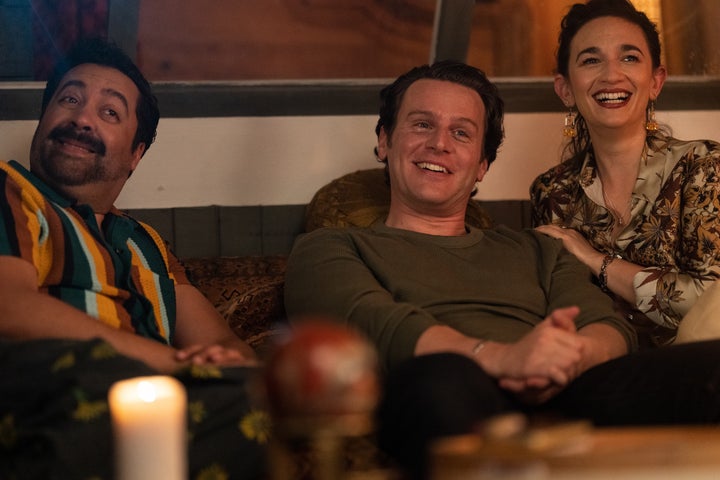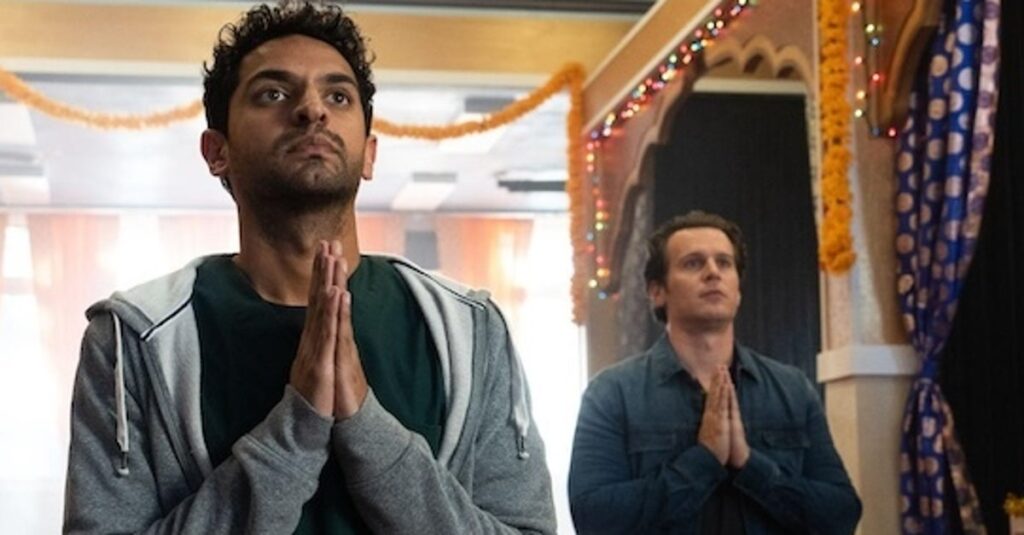“A Nice Indian Boy” is the fresh, original romantic comedy that I have been waiting for. It’s one of those rare movies with perfect comedic timing and will make everyone in the theater laugh while telling an emotional story. Directed by Roshan Sethi, the film will resonate with you long after the credits have rolled. Based on the play by Madhuri Shekar and adapted for the screen by Eric Randall, the story combines elements of both the American rom-com and the Indian Bollywood film to create a new and much-needed type of love story.
And, like every good love story, it has a great beginning.
“What will it look like when I bring home a nice Indian boy?” wonders Naveen (Karan Soni) as he sits off to the side at the wedding celebration of his sister Arundhathi (Sunita Mani). In the film’s first scene, as Naveen gazes longingly at the dancing before him, it’s clear that he wants what his sister has, but he’s not certain that he will ever have a big Indian wedding of his own.
This is partially because his parents are supportive in theory — they know he’s gay — but they’ve never seen him “be gay.” This leaves Naveen to hope for a wedding but doubt that he will ever have a husband like his sister’s Manish (Sachin Sahel).
This set-up is the prologue, and what follows is a story that begins six years later and is told in five chapters. In “Chapter 1 – The Boy,” Naveen meets Jay Kurundkar (Jonathan Groff), a white artist who was adopted and raised by Indian parents who have died. In the movie’s meet-cute moment, the two are worshipping in front of the Ganesh altar at the same temple. Even though they don’t speak or even make eye contact, the tension is palpable. When Jay gets up to leave, he rings a bell, symbolically setting their love story in motion.
The next day, the two bump into each other at the hospital where Naveen is a doctor. Jay is the photographer taking the employees’ pictures. He invites Naveen to go to a screening of his father’s favorite movie. Unaware that Jay was raised by Indian parents, Naveen is surprised that Jay invited him to go see DDLJ (“Diwale Dulhania Le Jayenge”), a classic Bollywood love story from the ’90s.
The rest of their date is an imperfect yet realistic scene in which they talk at a bar and get to know each other. As the two converse, it immediately becomes clear that another very American trope is being woven into the story — a grumpier, reserved realist falls in love with a sunshine-y, extroverted optimist. Naveen doesn’t “want to hear sweeping declarations of love. It’s 2024. The world is burning.” Meanwhile, Jay is dreaming of a big Indian wedding, and he loves DDLJ because “it doesn’t end with the couple getting together again like in an American movie … It’s about everybody together. The family. The wedding.”
This structure, and the fact that the movie accomplishes it in a tight 90 minutes, sets “A Nice Indian Boy” apart from other rom-coms. It is also just one way the film pays homage to DDLJ. From the bell in the meet-cute to the flowers and singing, “A Nice Indian Boy” consistently references the iconic movie in obvious and subtle ways.
In addition to its structure, the movie has an excellent cast. Naveen’s mom Megha (Zarna Garg) and dad Archit (Harish Patel) have incredible comedic timing. Also, their desire for their son to feel loved and supported comes across so strongly that I found myself rooting for the family to reconnect as much as I was rooting for Naveen and Jay’s relationship. Naveen’s best friend Paul (Peter S. Kim) is also a great scene partner and has similarly great comedic timing.
Between the structure, influence of DDLJ and major roles the family and friends play, it becomes clear that “A Nice Indian Boy” is telling a new type of love story that is more than two characters falling in love.

The four chapters that follow the meet-cute give audiences a fuller love story of two men integrating each other into their families. The plot goes from them falling in love to meeting Jay’s friends and Naveen’s family to getting engaged to making their declaration of love at a big Indian wedding of their own.
However, no chapter is conflict-free. From withholding information and a disastrous first meeting with Naveen’s parents, it looks like the wedding will never happen at all. Then, once the couple’s engagement is back on again, it seems like, as gay men, a traditional Indian wedding may be inaccessible.
Enjoy HuffPost Entertainment — Ad Free
Support HuffPost
Already contributed? Log in to hide these messages.
Thankfully, it’s not. And the culmination of the movie in “Chapter 5 – The Wedding” is what ultimately makes the story so deeply moving. When Naveen and Jay stand together under the mandap and exchange vows and circle the fire, it is both a universal symbol of love and represents that a love like theirs can exist and be celebrated within a more traditional Hindi culture.
I don’t want to spoil the final scene because it was even more beautiful, and I found myself tearing up in the way that movies rarely make me do anymore. It’s also this final moment that cements the movie as a new addition to the American rom-com canon and sets it apart for telling a developed story that is rooted in the traditions of multiple cultures at the same time.
“A Nice Indian Boy” is in theaters now.
Read the full article here


